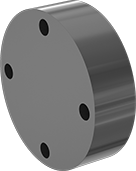How to Identify and Measure Fittings
Pipe size is an industry designation, not the actual size. View information about how to measure threaded and unthreaded pipe and pipe fittings.
More
Fiberglass Pipe Flanges for Corrosive Chemicals
- For Use With: Acetic Acid (75%), Alcohol, Calcium Chloride, Chlorine, Fuel Oil, Gasoline, Hydrochloric Acid (37%), Nitric Acid (10%), Oil, Phosphoric Acid, Salt Water (30%), Sodium Hydroxide (50%), Solvents, Sulfuric Acid (70%), Water
- Temperature Range: 32° to 200° F
- Specifications Met: ASTM D4024
Flanges have excellent corrosion resistance to handle a wide range of acids and other highly-corrosive chemicals. Use in metal surface treating applications, plating solution lines, and other chemical process applications. They are reinforced with fiberglass layers for better strength and durability than any of our other pipe flanges for chemicals. Bolt two same-size flanges together with a gasket (sold separately) to create an access point within a line. Flanges meet ASTM D4024 specifications and testing requirements for product dimensions, performance, and material quality.
To connect flanges to pipe, first sand the inside of the flange and the end of the pipe to remove the surface finish. Next, mix the adhesive (sold separately) until the color is uniform with no streaks. Apply a thin layer of mixed adhesive to the sanded area of the pipe, approximately 1/8” thick. Repeat this process with the inside of the flange, applying a layer approximately 1/16” thick. After sealant has been applied, push the flange onto the pipe until it is fully engaged. Make sure you align the bolt holes prior to installing to minimize rotation after the flange is installed. Finally, use the adhesive-curing heat cable (sold separately) to cure the adhesive. Wrap the tape around the pipe and flange at the joint, taking care to not overlap the tape. Once you have waited the full cure time, the pipe and flange will be ready to use.
Warning: Never use plastic pipe flanges and pipe with compressed air or gas.
For technical drawings and 3-D models, click on a part number.

Cap flanges are also known as blind flanges.
| Pipe Size | Flange OD | For Bolt Dia. | Bolt Hole Dia. | Number of Bolt Holes | Bolt Circle Dia. | Material | Color | Max. Pressure | Each | |
| 1 1/2 | 5" | 1/2" | 5/8" | 4 | 3 7/8" | Fiberglass | Black | 300 psi @ 72° F | 0000000 | 0000000 |
| 2 | 6" | 5/8" | 3/4" | 4 | 4 3/4" | Fiberglass | Black | 250 psi @ 72° F | 0000000 | 000000 |
| 3 | 7 1/2" | 5/8" | 3/4" | 4 | 6" | Fiberglass | Black | 250 psi @ 72° F | 0000000 | 000000 |
| 4 | 9" | 5/8" | 3/4" | 8 | 7 1/2" | Fiberglass | Black | 150 psi @ 72° F | 0000000 | 000000 |
| Pipe Cement (11.8-fl. oz. Can) | 0000000 | Each | 000000 |

| Voltage | Max. Heat Output, °F | Lg. | Wd. | Thick. | Plug Type | Cord Lg. | Each | |
| 120V AC | 270° | 6 ft. | 1" | 1/8" | Two Prong | 6 ft. | 0000000 | 0000000 |

























